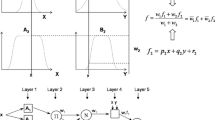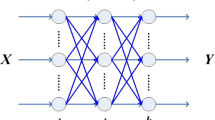Abstract
In our days the importance of reducing the inventory level in a healthcare organization is increasing fast. As a result, the value of an accurate supply forecast is becoming more relevant. The main objective of this paper is to analyze and compare some of the most popular and widely applied techniques available based on computational intelligence. In addition, it aims to demonstrate the competitiveness of the aforementioned using real-world data. The methods that are employed include neural networks (feed forward, radial basis, generalized regression, and recurrent networks) and the hybrid neural fuzzy system (ANFIS). The experimental part of this study is conducted with the use of sales’ data extracted from the database of a major Greek medical supplier. A two-year period was employed in order to gather the appropriate sales figures about some of the most popular medicines and subsequently each technique’s forecasting ability was tested against a third year. The parameters of each technique are then fine-tuned in order to minimize the performance functions. Finally, a brief statistical analysis of the techniques used is performed to facilitate the comparison between them and define the most appropriate method for this particular issue.






Similar content being viewed by others
References
Abdel-Aal RE, Mangoud AM (1998) Modeling and forecasting monthly patient volume at a primary health care clinic using univariate time-series analysis. Comput Methods Programs Biomed 56:235–247
Aburto L, Weber R (2007) Improved supply chain management based on hybrid demand forecasts. Appl Soft Comput 7(1):136–144
Agrawal D, Schorling C (1996) Market share forecasting: an empirical comparison of artificial neural networks and multinomial logit model. J Retailing 72(4):383–407
Ainscough TL, Aronson JE (1999) An empirical investigation and comparison of neural networks and regression for scanner data analysis. J Retailing Consum Serv 6(4):205–217
Al-Saba T, El-Amin I (1999) Artificial neural networks as applied to long-term demand forecasting. Artif Intell Eng 13(2):189–197
Atsalakis G, Valavanis K (2009) Forecasting stock market short-term trends using a neuro-fuzzy based methodology. Expert Syst Appl 36(7):10696–10707
Atsalakis G, Ucenic C, Skiadas C (2005) Time series prediction of the greek manufacturing index for the non-metallic minerals sector using a Neuro—Fuzzy approach (ANFIS). In: Applied stochastic models and data analysis conference, 17–20 May 2005 Brest
Bansal K, Vadhavkar S, Gupta A (1998) Neural networks based data mining applications for medical inventory problems. Int J Agile Manuf 1(2):187–200
Bonissone P, Chen YT, Goebel K, Khedkar P (1999) Hybrid soft computing systems—industrial and commercial applications. Proc IEEE 87(9):1641–1667
Chang PC, Wang YW, Tsai CY (2005) Evolving neural network for printed circuit board sales forecasting. Expert Syst Appl 29(1):83–92
Chu CW, Zhang GP (2003) A comparative study of linear and nonlinear models for aggregate retail sales forecasting. Int J Prod Econ 86:217–231
Darbellay GA, Slama M (2000) Forecasting consumers’ expenditure: a comparison between econometric and neural network models. Int J Forecast 12(2):255–267
Demuth H, Beale M (2002) Matlab neural network & fuzzy logic toolbox. MathWorks Inc, Natick
Diakoulakis IE, Koulouriotis DE, Emiris DM (2002) A review of stock market prediction using computational methods”. In: Kontoghiorghes E, Rustem B, Siokos S (eds) Computational methods in decision-making, economics and Finance. Applied Optimization, vol 72, Springer, pp 67–91. (ISBN: 78-1-4020-0839-9)
Elkateb MM, Solaiman K, Al-Turki Y (1998) A comparative study of medium weather-dependent load forecasting using enhanced artificial/fuzzy neural network and statistical techniques. Neurocomputing 23(1–3):3–13
Freeman JA, Skapura DM (1991) Neural networks–algorithms, applications and programming techniques. Addison-Wesley Pub co, Reading (USA)
Giles CL, Lawrence S, Tsoi AT (2001) Noisy time series prediction using a recurrent neural network and grammatical inference. Mach Learn 44(1–2):161–183
Gill PE, Murray W, Wright MH (1981) Practical optimization. Academic Press, London
HFMA (2002) Healthcare Financial Management Association. Resource Management: The healthcare supply chain 2002 survey results. Available from: http://www.hfma.org/library/accounting/costcontrol/Supply_Chain_2002_Survey.htm. Accessed 22 August 2005
Hill T, O’Conner M, Remus W (1994) Neural Networks for time series forecasting. Manage Sci 42(7):1082–1092
Hines JW, Uhrig RE, Tsoukalas LH (1997) Matlab supplement to fuzzy and neural approaches in engineering. Wiley, New York
Ioannides J (2009) Limits to forecasting in personalized medicine: an overview. Int J Forecast 25:773–783
Jang SR, Sun CT, Mizutani E (1997) Neuro-fuzzy and soft computing: a computational approach to learning and machine intelligence. Prentice-Hall, Upper Saddle River (USA)
Kaastra I, Boyd M (1996) Designing a neural network for forecasting financial and economic time series. Neurocomputing 10(3):215–236
Kirby HR, Watson SM, Dougherty MS (1997) Should we use neural networks or statistical models for short-term motorway traffic forecasting? Int J Forecast 13(1):43–50
Kolarik T, Rudorfer G (1994) Time series forecasting using neural networks. APL Quote Quad 25(1):86–93
Koulouriotis DE, Emiris DM, Diakoulakis IE, Zopounidis C (2002) Behavioristic analysis and comparative evaluation of intelligent methodologies for short term stock price forecasting. Fuzzy Econ Rev 7(2):23–57
Koulouriotis DE, Diakoulakis IE, Emiris DM, Zopounides C (2005) Development of dynamic cognitive networks as complex systems approximators: validation in financial time series”. Appl Soft Comput J 5(1):157–179
Kutsurelis J (1998) Forecasting financial markets using neural networks—an analysis of methods and accuracy. PhD thesis, Naval Postgraduate School, Monterey
Luxh JT, Riis JO, Stensballe B (1996) A hybrid econometric-neural network modeling approach for sales forecasting. Int J Prod Econ 43(2–3):175–192
Paliwal M, Kumar UA (2009) Neural networks and statistical techniques: a review of applications. Expert Syst Appl 36(1):2–17
Plummer EA (2000) Time series forecasting with feed-forward neural networks—guidelines and limitations. MSc thesis, University of Wyoming, Laramie
Prybutok VR, Yi J, Mitchell D (2000) Comparison of neural network models with ARIMA and regression models for prediction of Huston’s daily maximum ozone concentration. Eur J Oper Res 122:31–40
Rosales EM, Gan Q (2003) A comparative study on CMAC and ANFIS for nonlinear system modelling. In: Proceedings of the international conference on computational intelligence for modelling, control and automation. February 2003, Vienna
Villmann Th (2000) Neural maps for faithful data modelling in medicine—state-of-the-art and exemplary applications. Neurocomputing 48:229–250
Vlahavas I, Κefalas P, Vasiliadis N, Refanidis Y, Kokoras K, Sakellariou I (2006) Artificial intelligence. Giourdas Publications, Athens
Author information
Authors and Affiliations
Corresponding author
Rights and permissions
About this article
Cite this article
Koulouriotis, D.E., Mantas, G. Health products sales forecasting using computational intelligence and adaptive neuro fuzzy inference systems. Oper Res Int J 12, 29–43 (2012). https://doi.org/10.1007/s12351-010-0094-y
Received:
Revised:
Accepted:
Published:
Issue Date:
DOI: https://doi.org/10.1007/s12351-010-0094-y




